First look on Panasonic HDC-TM300e
Should I change MiniDV-cameras to HDD-cameras? Should I change SD video to HD video? Should I change Sony to Panasonic? Panasonic HDC-TM300 HD Camera Test

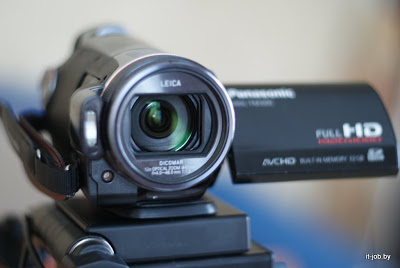
The answers to these questions are at the end of the article. The Panasonic representative kindly provided us with a test HD-camcorder Panasonic HDC-TM300ee - the flagship of its amateur model range 2009.
Since we shoot educational seminars relatively often (more than 40 hours of ready-made video, so much more is shot) - we are relatively rare " writers who know what to demand from the camera.
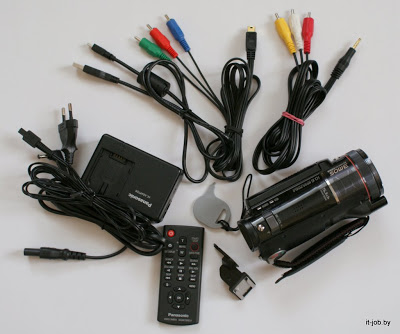
The camera attracted us, first of all, with its matrix. 3CMOS 1 / 4.1. And a built-in hard drive. Prior to this, all our experience with camcorders was from the miniDV era. And we shot first on a Panasonic GS27 (1/6 matrix), then Sony HC42 (1/5 matrix), then Sony HC90 (1/3 matrix with a primary color filter), then Panasonic MX400 (3CCD 1/6 matrix). The last camera is semi-professional.
So there is nothing to compare.
Convenience of use and additional equipment.
This Panasonic is an amateur camera, so everything is subject to the interests of amateurs. A touchscreen, which in any case will need to be used (and, therefore, camera shake when shooting and recording touch-shake), a frivolous 5.1 microphone.
Panasonic decided that the camera is self-sufficient - therefore, to connect external accessories, you need to carry a special adapter with you.

Which is a curved piece of iron with a non-contact area (cold shue). If Sony uses a sophisticated multi-pin connector to connect accessories, for example, allowing you to connect wireless microphones or lights and control them through the camera (i.e. the camera exchanges information with additional equipment), then in the Panasonic camera it's just a piece of iron / plastic. You can also install additional light on a tripod nearby. Holding TM300 with equipment installed, let's say, is inconvenient.
Sound
But Panasonic, and the TM300 was no exception, there is an important plus - standards. First of all, a standard microphone jack, a standard miniusb for draining video (moreover, the camera disc is visible just like a disc - without additional drivers or software). If you can endure “native” irreplaceable cables on cameras, you can still, then standard microphones are not. SONY, conditionally, has about 7 “native” microphones under the “smart platform”. Each costing from $ 100, and for a hundred you get is not very high quality. And you can’t connect a “standard” microphone.
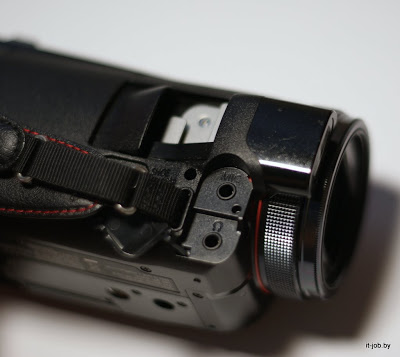
And you can connect any standard system to Panasonis. Let's say for $ 60-70 you can buy a fairly strong “gun” with its own power and Panasonic will be happy to record it stereo or mono along with the video. The second important plus is the ability to pick up sound from external sources. A typical scenario for educational events is when there is a microphone for sounding the hall (usually a radio or wired system), the signal from which is sent to the console. The most affordable sound quality in such conditions is to pick up the signal directly from the remote control. This is possible with Panasonic, but not with Sony.
The “zoom” function does not make an impression, in fact, the microphones are not refocused, but the signal amplification is simply turned on. Those. if, when “approaching the sound”, someone near the camera (say, to the left of the camera) starts discussing the lecturer, then the further the lecturer (the stronger zoom you use for recording), the more distinctly you will hear commentators. So this function is marketing garbage that has no practical use.
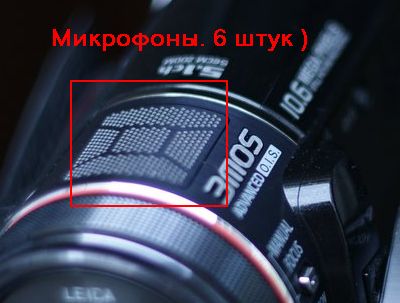
Honestly, the same situation is with 5.1. It is almost impossible to amateurly edit on a computer - it’s very “heavy” software, “dancing with a tambourine” and knowledge that requires working with six sound tracks. And even fewer situations where you can watch amateur video with 5.1 sound. Therefore, write in stereo mode with external microphones (by the way, only a stereo microphone can be connected externally. 6 channels cannot be connected for 5.1 recording).
But. One important “but.” The quality of the recorded sound through the built-in microphones is much better than the recorded built-in microphones in Sony. True, you should choose the appropriate sound recording mode. What is done only after putting the camera in manual mode :)
Video
Honestly, the camera was pleasantly surprised. The matrix showed more than decent results in poor lighting. The results are much more impressive than the 1/3 Sony matrix for much lower resolution. Another important plus: the camera adapts very quickly to new lighting conditions and “snap in” sharpness almost instantly. True, there is a problem - manual white balance (and this is a prerequisite for high-quality video) can be set only in manual mode. And in this mode it is impossible to set “tracking autofocus” - because it is a type of amateur function. If the presenter leaves the center of the frame, and there is a solid background behind him, the camera tries to find sharpness. Naturally, to no avail.
Tracking autofocus solves this problem. Moreover, it works even after the object has left the frame. When the lecturer returns to the frame, the camera again finds the object selected by the operator for focusing. But then the white balance - automatically)
From read
I read the discussion that for the present receipt of high-quality fullHD, the matrix size of 1/4 is small. I fundamentally agree, the idea is correct. If 1/3 the amateur camera for 768px in width had noise issues, then 1/4 for the resolution of 1900px in width - 1 pixel is much smaller than the physical size of the matrix. However, I am sure that “warm tube sound” and “cold tube sound” (referring to the quality of the captured video) can only be distinguished on very large and expensive plasma TVs with a magnifying glass when analyzing still images. In general, in an amateur video the “what” is more important than the “how” is shot.
What we are not
- Not tested the compression quality of the codec on running water
- Did not test the CMOS matrix on the shooting of a burning candle
- We did not test the 10 megapixel photo mode (because on a 1/4 matrix this is ridiculous. It’s just as ridiculous to make the camcorder be a camera)
Summary
The cost of the camera is about $ 1200. She is amateur. A regular battery lasts more than an hour and a half. The camera is sturdy but compact. There is a Russian language in the menu. A little surprised us by the separation of functions into "amateur" and "manual". And the fact that they can not be combined. In particular, it was frustrating that “tracking objects” is in the amateur part, and the white balance and switching the microphone to stereo mode are in manual settings.
The capabilities of this camera are more than enough for us. The matrix is less noisy than all that we managed to try (but all of them were MiniDV cameras), the sound with integrated microphones is recorded better and cleaner.
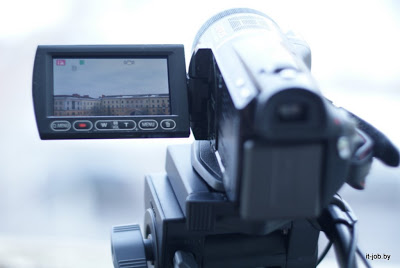
The computer sees a disk with .mts files located there, which are perfectly understood by default, say MediaPlayer Classic and ordinary modern amateur editing and encoding programs. (but even to watch HD you need a good computer, a laptop with Core2Duo, hmm hmm, it slows down)
If the unlim channel gets cheaper in Belarus, then it’s quite possible to upload HD versions of the material youtube or vimeo. If the Internet gets much cheaper, then it is very likely that HD versions will watch).
I was pleased that it was easy to get and handle the footage. However, HD processing requires an oooooooooooooooooo powerful computer.
The camera, in addition to the 160Gb hard drive, allows you to feed yourself with SD cards (the most expensive of which already have 32Gb, while remaining as small). Moreover, it is possible to rewrite data between the hard drive and the card without a computer!
The definite pluses are the support of STANDARD inputs / outputs. Separate microphone input, separate headphone output, A / V and composite outputs, HDMI (for direct connection to cool HD TVs), standard mini USB.
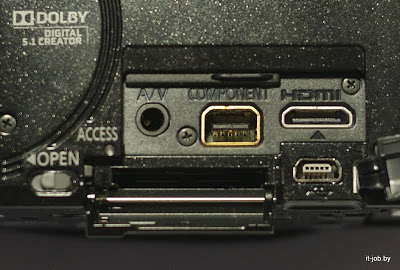
What can stop you from buying is the price. Such a camera will be bought by young families for shooting children only after a car, a plasma TV and a very very very powerful computer. This is not to say that for HD, a triple matrix and a touchscreen, the price is not fair. Devices for receiving similar quality, alas, cost so much.
But it’s obvious that the era of miniDV cameras has passed, cameras with hard drives are much more convenient and practical, a camera with standard inputs is much more attractive. Therefore, the answers to the questions posed in the title: Yes, yes, yes. Everything speaks for Panasonic.
